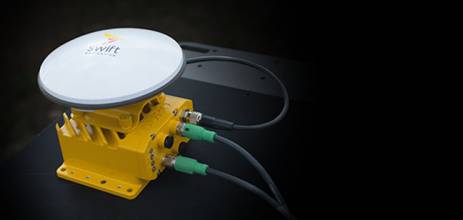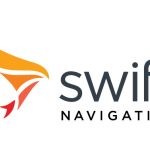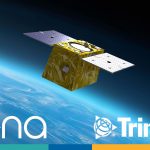Swift Navigation and Carnegie Robotics (CRL) rolled out their first joint product, a real-time kinematic (RTK) GNSS receiver called Duro, at the AUVSI XPONENTIAL trade show in Dallas, Texas, May 8-11.
The companies say Duro is targeted to robotics, precision agriculture, mapping, military, outdoor industrial and maritime markets.
Swift Navigation and Carnegie Robotics (CRL) rolled out their first joint product, a real-time kinematic (RTK) GNSS receiver called Duro, at the AUVSI XPONENTIAL trade show in Dallas, Texas, May 8-11.
The companies say Duro is targeted to robotics, precision agriculture, mapping, military, outdoor industrial and maritime markets.
“Duro is the combination of Swift’s centimeter-accurate GNSS technology and Carnegie Robotics’ robotic systems that are renowned for getting work done, in real-world applications,” said Fergus Noble, Swift Navigation co-founder and CTO.
Duro, which will be manufactured in California, may well be best-suited for outdoor robotic and precision agriculture equipment, though also rugged enough for other industries, said Diana Schlosser, Swift Navigation vice president of marketing. “It does not need to be placed inside a vehicle or in an air-conditioned environment, but can be easily mounted anywhere on the exterior of any farming machinery,” she said.
Schlosser said the receiver will be available in the third quarter of 2017 and will cost around $2,000. “A price point that will allow more farmers to add precision navigation and autonomous capabilities to more implements and tractors in their fleet,” she said.
Swift is focusing on the pricing as they say other centimeter-accurate, multi-band GNSS products are priced in the tens of thousands. “Duro is priced such that it could be added to smaller harvesting and crop maintenance vehicles, opening up this technology not just to agribusiness, but smaller, organic and local farming operations,” Schlosser said.
Carnegie Robotics developed the rugged 1P67 enclosure and integrated it with the Swift Navigation Piksi Multi GNSS receiver inside the cast aluminum housing, the company said.
The new GNSS receiver, which is a ruggedized version of Swift’s Piksi Multi product, features centimeter-accurate positioning, the companies said. The receiver is protected against weather, moisture, vibration, dust, water immersion and other problems that can occur in long-term outdoor environments.
Duro features multi-band and multi-constellation, capabilities, military-grade hardware, weatherproof external enclosure design, onboard micro-electro-mechanical system (MEMS) inertial measurement unit (IMU) and magnetometer.
The partnership between Swift Navigation and Carnegie Robotics was announced in March. The companies said they expected to introduce a line of navigation products for autonomous vehicles, outdoor robotics, unmanned aerial vehicles (UAVs) and machine control.
San Francisco-based Swift Navigation is a startup building centimeter-accurate GPS technology designed for new autonomous vehicles, while Carnegie Robotics, located in Pittsburgh, provides advanced robotics sensors and platforms for defense, agriculture, mining, city infrastructure and energy applications, the companies said.
The robotics market, through this partnership with Carnegie Robotics, stands to benefit from Piksi Multi’s improved localization and control, according to Swift. Featuring robotics positioning with advanced precision GNSS capabilities, the receiver module is well suited for the mass market.
The team at Carnegie Robotics has decades of experience successfully transitioning state-of-the-art technologies from early design into commercial use in precision agriculture, machine control, autonomous vehicles, and industrial and military robots.
“Seeing our first joint vision come to fruition with the launch of Duro marks an exciting milestone for a number of industries,” said Chris Osterwood, Carnegie Robotics CTO. “With Swift’s focus on high-accuracy and low-cost GNSS technology, we are bringing to market a much-needed solution with many real world applications in robotics, precision agriculture, infrastructure mapping, outdoor industrial and maritime vehicles.”
Rob Hranac, Swift Navigation business development, was equally excited about Duro when talking to Inside GNSS at XPONENTIAL.
“It’s very tailored to fast deployment,” Hranac said. “You put an antenna on it and it’s running quickly. We see a lot of pull in precision ag and mining and we’ve made it simple to deploy.”
Swift Navigation, founded in 2012, said its GNSS receivers are a fraction of the price of its competition, but deliver 100 times the accuracy of GPS systems in cell phones. CRL, founded in 2010, focuses on inertial-based, GPS-denied positioning and perception technologies, the company said. It offers its own product lines and custom product development.



 & Carnegie Robotics CTO Chris Osterwood (R).jpg)


